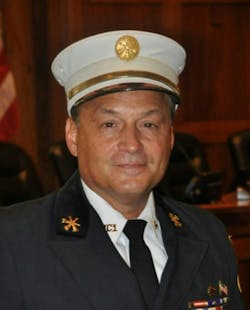Is there a difference between a mayday and urgent message? The answer is, yes, there should be. Research from a number of departments around the country on this subject shows that there are different interpretations of the words mayday and urgent. For many, the use of mayday signifies that a firefighter is in trouble and needs help. In other departments, mayday could have multiple meanings. Not only can the word identify that a member is in trouble, but it also could identify a potential building collapse, a loss of water in a hoseline or even the need to bring attention to a change in fire conditions.
What quickly became evident from this research was the need to keep the definition of the word mayday and its use simple by establishing ease with procedural knowledge and recognition—more specifically, eliminate multiple definitions, situations and the need to interpret under distress.
This approach could be emphasized further by reviewing past mayday incidents. By doing so, it quickly becomes evident that mayday radio transmissions often occur at the worst possible time during an incident. An escalating or deteriorating incident, accompanying radio traffic, combined with the anxiety and confusion that could come from hearing either a whole or partial emergency radio transmission, require that mayday and urgent radio transmissions not only have a clear definition and association but also have a clear and easily recognizable set of parameters. Lack of procedural knowledge and confusion with procedure design under distress are recognized difficulties regarding when and how to call a mayday.
Mayday parameters
Use of the word mayday identifies that a firefighter/fire officer became lost, trapped or seriously injured or exhausted his/her breathing air at the scene of an emergency incident. Specifically, a firefighter needs immediate help.
A firefighter/fire officer transmits a mayday when:
- Lost or trapped or a serious or life-threatening injury was sustained.
- Tangled or pinned and unable to free him/herself after the first attempt.
- The low air alarm is activated, and an exit can’t be seen.
- In zero visibility, no contact exists with a hoseline or search rope and the exit isn’t known.
- The primary exit is blocked by fire or collapse and an immediate secondary exit can’t be located.
- Having fallen through a floor, roof or staircase or down a shaft.
- Caught in a rollover condition and can’t find an exit.
- A serious or life-threatening injury to another member occurred.
- A lost, trapped, seriously injured or unconscious member is discovered.
Suggested mayday radio procedures
In an attempt to send as much useful information as possible in the shortest amount of time, remember the acronym M-WWW. It can be presented in two different forms.
- M—Mayday: To be announced three times.
- W—Who: Identify your radio designation (Engine 20, Ladder 10 Alpha, etc.).
- W—What: Give your situation (lost, trapped, injured, etc.).
- W—Where: Give your location and give floor, side, other (third floor, Side C, etc.)
Example: “Mayday, mayday, mayday. Ladder Company 10 Alpha. I’m trapped under a ceiling collapse. Third floor, Side C.
Alternatively, the transmission can be presented as:
- M—Mayday: To be announced three times.
- W—Where: Give your location and give floor, side, other (third floor, Side C, etc.)
- W—Who: Identify your radio designation (Engine 20, Ladder 10 Alpha, etc.).
- W—What: Give your situation (lost, trapped, injured, etc.).
Example: “Mayday, mayday, mayday. Third floor, Side C. Ladder Company 10 Alpha. I’m trapped under a ceiling collapse.”
The member who transmits the mayday must pause after each message and then repeat the message until acknowledged by the incident commander (IC).
The fire department fire dispatch center must relay any mayday messages that aren’t acknowledged immediately by the IC.
Mayday radio acknowledgement
It’s critical that all members who are at the scene of an emergency incident understand that mayday transmissions take priority over all other transmissions, including urgent messages.
When a mayday transmission occurs, the IC must attempt to clear the air of all other radio traffic and establish contact with the lost, trapped or injured member(s). Once contact is established, the IC should attempt to obtain more specific information that might assist in the rescue attempt if it proves necessary.
Example:
“Command to all units. Clear the radio for a mayday message.
“Command to Ladder 10 Alpha, go with your mayday.
“Ladder 10 Alpha, could you provide us with any other information?”
The requesting of other or more specific information is determined by the amount of information that originally was transmitted in the mayday, the square footage and layout of the building, and the needs of the IC and/or rapid intervention crew (RIC). Information requests could include but aren’t limited to:
- Can you tell us the best/closest access route to you?
- Can you hear a hose stream or saw that’s operating nearby?
- Are you near a stairway, shaftway, wall or other building feature?
- What’s the condition of the injured member(s)?
- What tool or equipment is needed?
Managing a mayday
Mayday events that involve a lost, trapped or injured firefighter or fire officer tax the resources and management of any incident. Incident management could be further taxed when multiple maydays are transmitted, and the incident is still evolving. ICs must maintain control and continuity of the incident by any means that are available to them. Options that are available to all commanders include but aren’t limited to:
- Using multiple RICs for deployment and replacement.
- Transmitting an additional alarm, which is an option for the IC at any time during the incident but is an advisable option when the fire still isn’t under control and there are no additional units in reserve or staging.
- Designating a separate radio frequency for the rescue or fire operation.
- Conducting a personnel accountability roll call to determine who and how many are missing.
- Collecting accountability tags and riding lists to determine who and how many are missing.
- Reviewing tactical worksheets and command boards to identify company/members’ last assigned location.
- Establishing and supporting a rescue group/operation within your incident management.
- Verifying that fire suppression operations are continuing.
- Removing all nonessential personnel.
- Eliminating freelancing and establishing control.
- Requesting any additional resources and equipment that might be needed.
Urgent operating guideline
To give further clarity to the use of the urgent reference, the following guideline identifies its use when a situation at the scene of an emergency incident produces a life-threatening situation. Although situations vary, some of the more common that might fit this category include: fear of a potential collapse from a wall or roof or of total building failure; a loss of water on the fire floor with firefighters working above; and the release of a pressure relief valve on a pressurized tank that’s involved or exposed to fire. In either case, the objective of this identification is to provide early notification to members in an attempt to prevent an injury or a death.
Urgent transmission parameters
Use of the word urgent identifies that a life-threatening situation developed that could affect firefighter safety.
A firefighter/fire officer transmits an urgent message when any of the following conditions exist:
- Serious/deteriorating change in fire conditions.
- Interior attack is going to be discontinued and exterior attack is being prepared.
- Discovery of a structural problem that indicates a potential or imminent collapse.
- Fire is discovered entering an exposure building to a degree that any delay might enlarge the fire problem considerably.
- Loss of water, which would endanger members.
- Excessive wind condition on the fire floor, which could extend the fire rapidly, endangering members.
- Downed electrical wire on the fireground or on a fire apparatus.
- A disoriented, unconscious or trapped civilian is located.
- Potential injury or death warrants priority.
- Any life-threatening situation or event occurred or is developing.
- Other situations that are considered urgent.
Suggested urgent radio transmission procedure
Members are to utilize and follow the urgent radio guideline as outlined below. In an attempt to send as much useful information as possible in the shortest amount of time, remember the acronym U-WWW.
- U—Urgent
- W—Who: Identify your radio designation (Engine 20, Ladder 10 Alpha, etc.)
- W—What: Give your situation (be specific)
- W—Where: Give your location and give floor, side, other (third floor, Side C, etc.)
Example: “Urgent command from Engine 20. We lost water on the fire floor.”
The member who transmits the urgent message must pause after each message and then repeat the message until acknowledged by the IC.
The fire department fire dispatch center must relay any urgent messages that aren’t acknowledged immediately by the IC.
Urgent acknowledgement
It’s critical that all members who are at the scene of an emergency incident understand that urgent radio transmissions take priority over all other transmissions, with the exception of a mayday message(s). When an urgent transmission occurs, the IC must attempt to clear the air of all other radio traffic and establish contact with the member who transmitted the urgent message. Once contact is established, the IC should attempt to obtain more specific information about the situation of the transmitting member if it proves necessary.
Example:
“Command to all units. Clear the radio for an urgent message.
“Command to Engine 20, go with your urgent message.
“Engine 20, could you provide us with any additional information?
“Engine 20, do you need any assistance?”
The requesting of other or more specific information is determined by the amount of information that originally was transmitted in the urgent message. Information requests could include, but aren’t limited to:
- If a serious/deteriorating change in fire condition exists, obtain information about the location and affected areas.
- If a discovery of a structural problem that indicates an imminent collapse concern exists, immediately evacuate the building and follow the defensive/evacuation procedure.
- If a structural problem that indicates an eventual collapse concern is discovered, obtain information about the location and the potentially affected areas.
- If fire is discovered entering an exposure building to a degree that any delay may considerably enlarge the fire problem, obtain information about the location and affected areas.
- If a loss of water, which would endanger members, exists, ask location/floor, members affected and the company that lost water.
- If an excessive wind condition on the fire floor could extend the fire rapidly, endangering members, obtain information on floor, side, and options to correct or avoid injury.
- If an unconscious, trapped or disoriented civilian is found or located, obtain information about removal and assistance, etc.
Simple definitions
The definition of the words mayday and urgent must be simple, to establish ease with procedural knowledge and recognition. Multiple definitions and situations and the need to interpret under distress must be eliminated.
About the Author

Michael Terpak
Michael Terpak has been in the fire service for 45 years, spending the last 36 years with the Jersey City, NJ, Fire Department, where he recently retired as a deputy chief and citywide tour commander. Terpak travels extensively, lecturing on fire/rescue topics. He is the founder of Promotional Prep, which is a New Jersey-based consulting firm that's designed to prepare firefighters and fire officers who are studying for promotional exams. Terpak, who holds a bachelor’s degree in fire safety administration from the City University of New Jersey, is the author of five books: "Fire Ground Size-Up" (first and second editions), "Assessment Center Strategy and Tactics," "Fire Ground Operational Guides," "Assessment Center Management and Supervision" and "Fire Officer Oral Assessment Study Guides."
